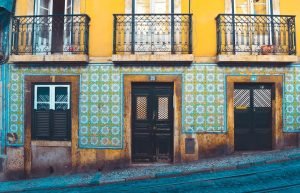
Das F1-Erbe von Portimao
Portimao, eine Küstenstadt in der portugiesischen Algarve-Region, hat sich in den letzten Jahren zu einem wichtigen Ziel für Formel-1-Rennen entwickelt. Diese Entwicklung ist auf mehrere Faktoren zurückzuführen
The art scene in Portugal is a vibrant and diverse community that is rich in history and creativity. From its historical roots to its contemporary creations, Portuguese art offers a unique perspective that is worth exploring. Understanding the Portuguese art scene is not only important for art enthusiasts, but also for those interested in learning about the country’s cultural identity and its place in the global art world.
Portuguese art has been influenced by a variety of historical factors, including the country’s rich maritime history, its colonial past, and its strong Catholic tradition. These influences can be seen in the themes, motifs, and techniques used by Portuguese artists throughout history.
For example, the maritime history of Portugal is reflected in the use of seascapes and nautical imagery in many works of art. Artists like Josefa de Óbidos and Domingos Sequeira were known for their depictions of ships, sailors, and coastal landscapes. These themes continue to be explored by contemporary Portuguese artists, who often incorporate elements of the sea and navigation into their work.
The colonial past of Portugal also had a significant impact on its art. The country’s exploration and colonization of territories in Africa, Asia, and South America brought new influences and artistic traditions to Portugal. This can be seen in the use of vibrant colors, intricate patterns, and exotic subject matter in many Portuguese artworks.
Portuguese artists have employed a wide range of styles and techniques throughout history. From traditional painting and sculpture to more experimental forms of expression, Portuguese artists have embraced diversity and innovation.
One notable style in Portuguese art is the “azulejo,” which refers to the traditional ceramic tiles that are commonly used to decorate buildings in Portugal. These tiles often feature intricate patterns and vibrant colors, creating a unique visual language that is distinctly Portuguese. Artists like Maria Keil and Júlio Pomar have incorporated the azulejo tradition into their work, creating stunning pieces that blur the line between art and architecture.
Another notable technique used by Portuguese artists is “fado,” a form of music that is deeply rooted in Portuguese culture. Fado is often described as a melancholic and soulful genre, and many artists have sought to capture its essence through visual art. Artists like Paula Rego and Helena Almeida have used their work to explore the emotions and narratives associated with fado, creating powerful and evocative pieces.
Portuguese art has played a crucial role in shaping the country’s cultural identity. Through its exploration of historical themes, its celebration of national symbols, and its promotion of local traditions, Portuguese art has helped to foster a sense of pride and unity among the Portuguese people.
One example of how Portuguese art has contributed to the country’s cultural identity is through its depiction of national heroes and historical events. Artists like Columbano Bordalo Pinheiro and Amadeo de Souza-Cardoso have created powerful portraits of important figures in Portuguese history, such as King Dom Sebastião and Luís de Camões. These artworks not only celebrate the achievements of these individuals, but also serve as reminders of the country’s rich heritage.
Portuguese art has also been used to promote national pride and unity through its exploration of local traditions and customs. Artists like Paula Rego and Joana Vasconcelos have incorporated elements of Portuguese folklore and traditional crafts into their work, creating pieces that are deeply rooted in the country’s cultural heritage. These artworks not only preserve these traditions for future generations, but also serve as symbols of national identity.
Globalization has had a significant impact on Portuguese art, bringing new influences, ideas, and trends to the country. Portuguese artists have responded to these global influences in a variety of ways, incorporating them into their work and pushing the boundaries of traditional artistic practices.
One way that globalization has affected Portuguese art is through the exploration of new materials and techniques. Artists like Joana Vasconcelos and Pedro Cabrita Reis have embraced unconventional materials, such as textiles, found objects, and industrial materials, to create innovative and thought-provoking artworks. These artists have also embraced new technologies, such as digital media and video installations, to create immersive and interactive experiences for viewers.
Globalization has also brought new perspectives and ideas to Portuguese art. Artists like Julião Sarmento and Helena Almeida have been influenced by international art movements, such as conceptual art and performance art, and have incorporated these ideas into their work. This cross-pollination of ideas has helped to expand the boundaries of Portuguese art and bring it into conversation with the global art world.
In recent years, Portugal has seen the emergence of new artistic trends that are shaping the future of Portuguese art. These trends reflect the changing social, political, and cultural landscape of the country, and offer new perspectives on traditional artistic practices.
One notable trend in Portuguese art is the exploration of identity and belonging. Artists like Grada Kilomba and Vasco Araújo have used their work to challenge traditional notions of identity and explore themes of race, gender, and sexuality. These artists are pushing the boundaries of Portuguese art by addressing issues that are often marginalized or overlooked in mainstream society.
Another trend in Portuguese art is the use of public spaces as a canvas for artistic expression. Artists like Alexandre Farto (aka Vhils) and Bordalo II have transformed urban landscapes with their large-scale murals and sculptures. These artworks not only beautify public spaces, but also serve as a form of social commentary, addressing issues such as urbanization, consumerism, and environmental degradation.
Technology is playing an increasingly important role in Portuguese art, with artists using digital media, virtual reality, and interactive installations to create immersive and engaging experiences for viewers. This intersection of art and technology is pushing the boundaries of traditional artistic practices and opening up new possibilities for creative expression.
One example of how technology is being used in Portuguese art is through the use of digital media. Artists like Miguel Palma and Leonor Antunes have embraced digital technologies to create interactive installations that blur the line between the physical and virtual worlds. These artworks invite viewers to engage with the artwork in new and unexpected ways, creating a dynamic and participatory experience.
Another example of how technology is being used in Portuguese art is through the use of virtual reality. Artists like Daniel Canogar and João Martinho Moura have created immersive virtual reality experiences that transport viewers to new worlds and challenge their perceptions of reality. These artworks not only push the boundaries of traditional artistic practices, but also offer new ways of experiencing and engaging with art.
Public art plays a crucial role in Portuguese culture, serving as a form of cultural expression, social commentary, and community engagement. Public art installations can be found throughout the country, from city squares to rural landscapes, and offer a unique way for artists to connect with the public and shape the cultural landscape.
One notable example of public art in Portugal is the “Casa da Música” in Porto. Designed by Dutch architect Rem Koolhaas, this iconic building serves as a concert hall and cultural center, and has become a symbol of modern architecture in Portugal. The building’s unique design and striking façade make it a popular destination for locals and tourists alike, and it serves as a hub for artistic and cultural activities in the city.
Another notable example of public art in Portugal is the “Boca do Inferno” in Cascais. This natural rock formation has been transformed into a stunning art installation by Portuguese artist Bordalo
Museums and galleries play a crucial role in promoting Portuguese art, providing a platform for artists to showcase their work, engage with audiences, and contribute to the cultural landscape of the country. These institutions not only preserve and exhibit artworks, but also serve as educational resources and cultural hubs for the community.
One notable museum in Portugal is the Museu Nacional de Arte Antiga in Lisbon. This museum houses an extensive collection of Portuguese art, including paintings, sculptures, ceramics, and textiles from the Middle Ages to the present day. The museum’s collection offers a comprehensive overview of Portuguese art history and provides visitors with an opportunity to explore the country’s cultural heritage.
Another notable gallery in Portugal is the Fundação Calouste Gulbenkian in Lisbon. This private foundation houses a diverse collection of art from around the world, including works by Portuguese artists such as Paula Rego, Helena Almeida, and Joana Vasconcelos. The foundation also hosts temporary exhibitions, concerts, and performances, making it a vibrant cultural center in the heart of Lisbon.
The art scene in Portugal is thriving, with artists pushing the boundaries of traditional artistic practices and exploring new forms of expression. From its historical roots to its contemporary creations, Portuguese art offers a unique perspective that is worth exploring. By understanding the historical influences, diverse styles and techniques, and the role of Portuguese art in shaping the country’s cultural identity, we can gain a deeper appreciation for the vibrant and dynamic art scene in Portugal. With the emergence of new artistic trends, the intersection of art and technology, and the importance of public art and museums in promoting Portuguese art, the future looks bright for Portuguese artists as they continue to innovate and contribute to the global art world.
If you’re interested in exploring the pros and cons of remote work and how coworking spaces can embrace it, check out this informative article: Pros and Cons of Remote Work and How Coworking Spaces Can Embrace It. It provides valuable insights into the changing landscape of work and offers practical tips for both remote workers and coworking spaces.

Portimao, eine Küstenstadt in der portugiesischen Algarve-Region, hat sich in den letzten Jahren zu einem wichtigen Ziel für Formel-1-Rennen entwickelt. Diese Entwicklung ist auf mehrere Faktoren zurückzuführen

Die Algarve-Region in Portugal ist für ihre vielfältigen Attraktionen bekannt, zu denen neben den berühmten Stränden und malerischen Landschaften auch eine florierende Weinindustrie gehört. Die Region ist

Das öffentliche Verkehrssystem Portugals ist eine effiziente und bequeme Art, das Land zu erkunden. Es gibt eine Vielzahl von Verkehrsmitteln, darunter Metro, Straßenbahn,